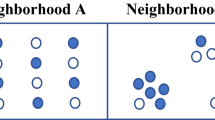Abstract
Spatial methods that build upon Geographic Information Systems are spreading quickly across the social sciences. This essay points out that the appropriate use of spatial tools requires more careful thinking about spatial concepts. As easy as it is now to measure distance, it is increasingly important to understand what we think it represents. To interpret spatial patterns, we need spatial theories. We review here a number of key concepts as well as some of the methodological approaches that are now at the disposal of researchers, and illustrate them with studies that reflect the very wide range of problems that use these tools.







Similar content being viewed by others
References
Anselin, L. (1995). Local indicators of spatial association—LISA. Geographical Analysis, 27(2), 93–115.
Chaix, B., Merlo, J., Subramanian, S. V., Lynch, J., & Chauvin, P. (2005). Comparison of a spatial perspective with the multilevel analytical approach in neighborhood studies: The case of mental, behavioral disorders due to psychoactive substance use in Malmö, Sweden, 2001. American Journal of Epidemiology, 162(2), 171–182.
Chomitz, K. M., & Gray, D. A. (1996). Roads, land use, and deforestation: A spatial model applied to Belize. The World Bank Economic Review, 10(3), 487–512.
Diggle, P. J. (1983). Statistical analysis of spatial point patterns. New York: Academic Press.
Diggle, P. J., Tawn, J. A., & Moyeed, R. A. (1998). Model-based geostatistics. Journal of the Royal Statistical Society Series C (Applied Statistics), 47(3), 299–350.
Downey, L. (2006). Environmental racial inequality in Detroit. Social Forces, 85(2), 771–796.
Entwisle, B., Rindfuss, R. R., Walsh, S. J., Evans, T. P., & Curran, S. R. (1997). Current geographic information systems, spatial network analysis, and contraceptive choice. Demography, 34(2), 171–187.
Gatrell, A. C., Bailey, T. C., Diggle, P. J., & Rowlingson, B. S. (1996). Spatial point pattern analysis and its application in geographical epidemiology. Transactions of the Institute of British Geographers, 21(1), 256–274.
Johnson, K. M., Voss, P. R., Hammer, R. B., Fuguitt, G. V., & McNiven, S. (2005). Temporal and spatial variation in age-specific net migration in the United States. Demography, 42(4), 791–812.
Kelsall, J., & Wakefield, J. (2002). Modeling spatial variation in disease risk: A geostatistical approach. Journal of the American Statistical Association, 97(459), 692–701.
Logan, J. R., Zhang, W., & Alba, R. D. (2002). Immigrant enclaves and ethnic communities in New York and Los Angeles. American Sociological Review, 67(2), 299–322.
Pais, J. F., & Elliott, J. R. (2008). Places as recovery machines: Vulnerability and neighborhood change after major hurricanes. Social Forces, 86(4), 1415–1453.
Pan, W., Carr, D., Barbieri, A., Bilsborrow, R., & Suchindran, C. (2007). Forest clearing in the Ecuadorian Amazon: A study of patterns over space and time. Population Research and Policy Review, 26(5–6), 635–659.
Pastor, M., Sadd, J. L., & Morello-Frosch, R. (2004). Waiting to inhale: The demographics of toxic air release facilities in 21st-Century California. Social Science Quarterly, 85(2), 420–440.
Raudenbush, S. W., & Bryk, A. S. (2002). Hierarchical linear models: Applications and data analysis methods. Thousand Oaks, CA: Sage Publications Inc.
Reardon, S. F., Matthews, S. A., O’Sullivan, D., Lee, B. A., Firebaugh, G., Farrell, C. R., et al. (2008). The geographic scale of metropolitan racial segregation. Demography, 45(3), 489–514.
Siqueira, J. B., Martelli, C. M. T., Maciel, I. J., Oliveira, R. M., Ribeiro, M. G., Amorim, F. P., et al. (2004). Household survey of dengue infection in central Brazil: Spatial point pattern analysis and risk factors assessment. American Journal of Tropical Medicine and Hygiene, 71(5), 646–651.
Skinner, G. W., Henderson, M., & Jianhua, Y. (2000). China’s fertility transition through regional space: Using GIS and census data for a spatial analysis of historical demography. Social Science History, 24(3), 167–206.
Snijders, T. A. B., & Bosker, R. J. (1999). Multilevel analysis: An introduction to basic and advanced multilevel modeling. Thousand Oaks, CA: Sage Publications Inc.
Tolnay, S. E., White, K. J. C., Crowder, K. D., & Adelman, R. M. (2005). Distances traveled during the great migration: An analysis of racial differences among male migrants. Social Science History, 29(4), 523–548.
Voss, P. R. (2007). Demography as a spatial social science. Population Research and Policy Review, 26(5), 457–476.
Wiseman, R. F., & Virden, M. (1977). Spatial and social dimensions of intraurban elderly migration. Economic Geography, 53(1), 1–13.
Wong, D. W. S. (1999). Several fundamentals in implementing spatial statistics in GIS: Using centrographic measures as examples. Geographic Information Sciences, 5(2), 163–174.
Wood, S. N. (2004). Stable and efficient multiple smoothing parameter estimation for generalized additive models. Journal of the American Statistical Association, 99(467), 673–686.
Author information
Authors and Affiliations
Corresponding author
Rights and permissions
About this article
Cite this article
Logan, J.R., Zhang, W. & Xu, H. Applying spatial thinking in social science research. GeoJournal 75, 15–27 (2010). https://doi.org/10.1007/s10708-010-9343-0
Published:
Issue Date:
DOI: https://doi.org/10.1007/s10708-010-9343-0



